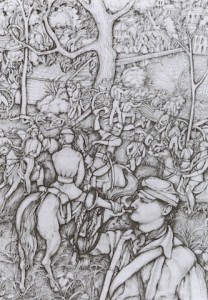|
J. William T. "Bill" Youngs, American Realities, Volume One:
Historical Episodes from First Settlements to the Civil War, Chapter Fifteen |
Slideshow images courtesy of Wiki Commons
|
15. The Civil War
|
SummaryThis essay describes the early life and wartime experiences of two soldiers, William Wheeler of New York and Charles C. Jones, Jr., of Georgia. We follow Wheeler’s career as an artillery officer in Virginia, Pennsylvania, Tennessee, and Georgia. Then we turn to Jones who, like Wheeler, went to Harvard Law School and, after serving briefly as mayor of Savannah, became an artillery officer. By observing their lives and thoughts we come to see the reasons why people on both sides believed they were fighting for a righteous cause.
|
Author reads from the Text
He [William Wheeler] acknowledged, however, that when he was not occupied by present duties, a longing for home swept through him. On a “beautiful Sabbath afternoon” in the South he thought of his mother walking through the autumn leaves on her way to church. He missed good conversation and domestic surroundings: “a quiet supper with a chosen crowd . . . and then a sensible chat over the apples and Madeira until the small hours.” He begged his family and friends to fill their letters to him with the details of daily life. “It is the neat little touches thrown skillfully in,” he wrote, “that make the home picture glow with life, and make the heart of the absent member beat warmly as he looks at it.”
Affected as he was by memories of his home, he found himself sympathizing with the people whose lands the northern armies occupied. He could speak facetiously of “fried secessionists for breakfast,” and he fired cannon shot at the enemy with unbridled enthusiasm. But when he came face to face with southerners his feelings changed. As the soldiers marched along, they often saw women “dressed in black and weeping as if their hearts would break.” In Virginia Wheeler sought to prevent excessive demands on the local farmsteads, interfering in one case, “in favor of a sheep, some bee-hives, and the potato patch” and winning in return an invitation to dinner. He was solicitous of enemy soldiers wounded in battle. At Gettysburg he walked among the southerners where they “lay scattered over the field in groups of twenty, fifty, or even a hundred.” Wheeler brought water to one, propped another on his side, and rigged up a bed of straw for a third.
Affected as he was by memories of his home, he found himself sympathizing with the people whose lands the northern armies occupied. He could speak facetiously of “fried secessionists for breakfast,” and he fired cannon shot at the enemy with unbridled enthusiasm. But when he came face to face with southerners his feelings changed. As the soldiers marched along, they often saw women “dressed in black and weeping as if their hearts would break.” In Virginia Wheeler sought to prevent excessive demands on the local farmsteads, interfering in one case, “in favor of a sheep, some bee-hives, and the potato patch” and winning in return an invitation to dinner. He was solicitous of enemy soldiers wounded in battle. At Gettysburg he walked among the southerners where they “lay scattered over the field in groups of twenty, fifty, or even a hundred.” Wheeler brought water to one, propped another on his side, and rigged up a bed of straw for a third.

